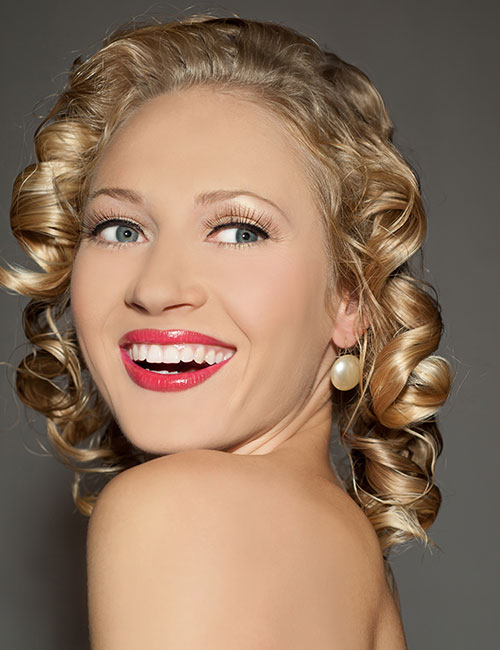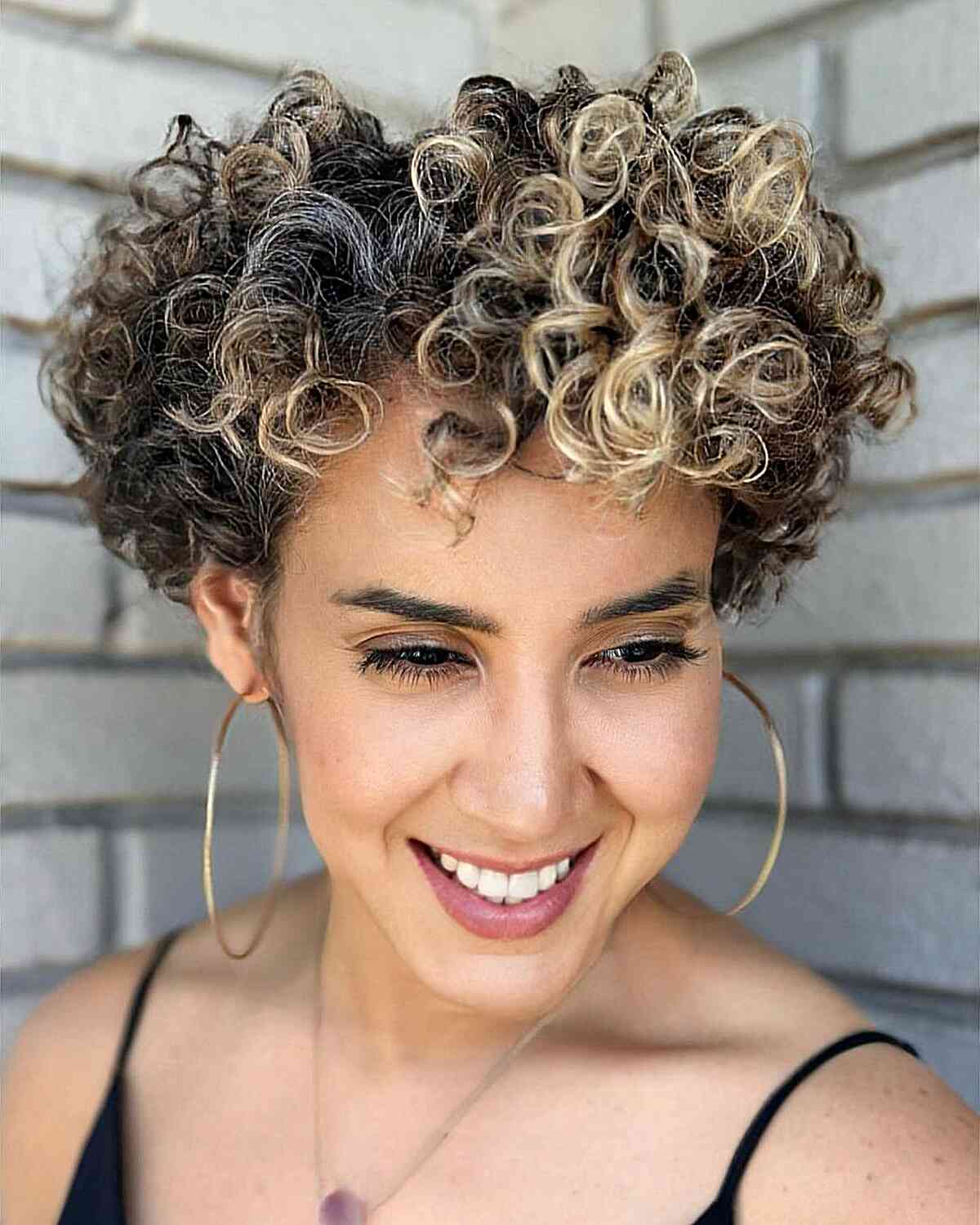50s Hairstyles for Curly Hair: A Comprehensive Guide to Mid-Century Curls

The 1950s stands as a pivotal decade in the annals of fashion and beauty, a period that meticulously sculpted ideals of glamour, femininity, and polished appearance. Within this era, hair played an exceptionally significant role, serving as a crowning glory that often dictated the overall aesthetic. For individuals blessed with natural waves and curls, the mid-century presented a unique set of challenges and opportunities, leading to the development of distinct styling techniques that embraced texture while adhering to the prevailing standards of neatness and sophistication. This article delves into the intricacies of these iconic looks, exploring the methods, influences, and enduring appeal of the era’s textured hair designs.
The defining characteristic of mid-century curly coiffures was an emphasis on structure, definition, and volume. The casual, undone look was largely absent; instead, meticulous setting and styling were paramount. This dedication to precision meant that naturally curly hair, while celebrated for its inherent body, was rarely left to its own devices. Instead, it was expertly manipulated to achieve uniform curl patterns, sleek finishes, and often, gravity-defying height. The underlying principle was control – transforming natural texture into a refined, intentional statement.
One of the foundational techniques for achieving these sculpted looks was the pin curl. This method involved taking small sections of damp hair, coiling them tightly around a finger, and then securing the resulting curl flat against the scalp with a bobby pin. Once the hair was completely dry, the pins were removed, and the tightly wound curls were gently brushed or finger-combed into the desired shape. Pin curls were versatile, allowing for the creation of various curl sizes and directions, from tight ringlets to softer, more voluminous waves. For those with naturally curly locks, pin curling offered a way to standardize and refine their existing texture, ensuring every strand contributed to a cohesive, polished look.
As the decade progressed, roller sets gained immense popularity, offering a more efficient and often more uniform alternative to pin curls, particularly for achieving greater volume. Hair was sectioned, a setting lotion or mousse was applied, and then each section was wound onto a roller, typically made of plastic or mesh. Rollers came in various sizes, allowing for customization of curl tightness and volume. Larger rollers created softer waves and lift, while smaller ones produced tighter, more defined curls. After the hair dried, often under a bonnet dryer, the rollers were removed, and the resulting springy curls were brushed out to form a smooth, voluminous style. For individuals with textured hair, roller setting was instrumental in taming frizz and imposing a consistent curl pattern, leading to the sleek, bouncy styles seen on screen and in magazines.
Among the most iconic of the shorter curly styles was the Poodle Cut. This vivacious and playful coiffure featured tightly curled hair, often achieved through extensive pin curling or small roller sets, concentrated around the crown and sides, creating a rounded, voluminous silhouette. The back and sides were typically kept shorter and closer to the head, emphasizing the curled top. Worn by stars like Lucille Ball, whose signature red curls became synonymous with the style, the Poodle Cut exuded charm and personality. It was a testament to how natural texture could be transformed into a distinct, fashionable statement, offering a practical yet glamorous option for those who preferred shorter lengths.
While the full-blown bouffant became more prominent in the early 1960s, its foundations were laid in the late 1950s, often incorporating backcombing and structured curls to achieve significant volume. For individuals with textured hair, this meant that the natural body of their curls could be leveraged, enhanced by strategic backcombing at the roots and then smoothed over with defined, often large, curls or waves. This approach allowed for an impressive display of height and grandeur, maintaining the era’s penchant for sculpted elegance.
Softer waves and elements like Victory Rolls also found their place within the curly hair lexicon of the 1950s. While Victory Rolls are often associated with the 1940s, their influence carried into the subsequent decade, often adapted with a more structured, polished finish. For textured hair, this might involve setting the hair in large, loose curls or waves, then carefully rolling and pinning sections at the front or sides of the head to create the distinctive upward-swept rolls. The natural body of curly hair provided an excellent base for these voluminous rolls, ensuring they held their shape with minimal effort.
The Pageboy, a neat, rounded style, also saw curly variations. For medium-length textured hair, this involved setting the hair in a way that encouraged the ends to curl under, creating a smooth, inward-curling bob. The natural spring of curls could be utilized to create this rounded silhouette, often with the addition of setting lotions to ensure a sleek, uniform finish.
Side parts and bangs were integral elements that framed the face and integrated seamlessly with the overall curly aesthetic. A deep side part often added a touch of drama and sophistication, allowing for a voluminous sweep of hair across the forehead. Bangs, whether soft and feathered or neatly curled under, provided a focal point and softened the face, complementing the structured curls.
Beyond the techniques, accessories played a crucial role in enhancing and maintaining these elaborate styles. Scarves, headbands, and hairnets were not merely decorative but practical tools for keeping curls in place, especially on windy days or during activities. Elaborate fascinators and decorative clips added a touch of formal elegance, turning a well-styled head of curls into a true work of art.
The cultural context of the 1950s heavily influenced these hair trends. Hollywood stars like Marilyn Monroe (whose iconic blonde waves were meticulously set), Elizabeth Taylor, and the aforementioned Lucille Ball, served as beauty ideals, their polished appearances gracing magazine covers and movie screens. Fashion magazines disseminated these looks, providing detailed instructions for women to recreate them at home. Societal expectations placed a high value on women presenting a neat, feminine, and well-groomed image, and hair was a primary canvas for achieving this.
The emergence of new products and tools also facilitated these elaborate styles. Setting lotions became indispensable for providing hold and definition during the drying process. Hairspray, a relatively new innovation, quickly became a staple for locking in styles and combating humidity. Bobby pins, hairnets, various brushes, and combs were essential in every woman’s beauty arsenal, enabling the intricate manipulation and shaping required.
The importance and benefits of these mid-century curly looks extended beyond mere aesthetics. They offered individuals with textured hair a sense of control and mastery over their natural volume and curl pattern, allowing them to achieve a consistently glamorous and sophisticated appearance. These styles celebrated femininity, providing a powerful means of self-expression within the era’s refined aesthetic. They demonstrated that natural texture, when skillfully managed, could be transformed into looks of unparalleled elegance and poise, leaving a lasting legacy that continues to inspire.
FAQs by 50s hairstyles for Type 3C Curly Hair Men A Comprehensive Guide To Understanding And Managing This Distinctive Texture curly hair
Q1: What defined the overall aesthetic of mid-century curly hair?
A1: The overall aesthetic was characterized by neatness, definition, and volume. Hair was meticulously set and styled to achieve uniform curl patterns, sleek finishes, and often, significant height, adhering to the era’s standards of polished sophistication.
Q2: Were natural curls always embraced, or were specific setting techniques preferred?
A2: While natural body was appreciated, specific setting techniques like pin curls and roller sets were overwhelmingly preferred. These methods allowed for precise control over the curl pattern, ensuring uniformity, longevity, and a polished appearance that natural, unstyled curls often could not provide.
Q3: What were common tools and products used for achieving these looks?
A3: Essential tools included bobby pins, various sizes of hair rollers, and combs. Key products comprised setting lotions or mousses for hold and definition during drying, and hairspray for locking in the final style and preventing frizz. Bonnet dryers were also frequently used to expedite the drying process for set hair.
Q4: Did these styles cater to all curl types?
A4: These styles were adaptable to a range of curl types, but often required significant manipulation. Individuals with very tight curls might need to loosen them through setting, while those with very loose waves would need to create more defined curls. The goal was always a structured, uniform pattern rather than a purely natural one.
Q5: How did shorter curly styles differ from longer ones during this period?
A5: Shorter curly styles, such as the Poodle Cut, typically featured tightly sculpted curls concentrated around the crown and sides, creating a rounded, voluminous silhouette. Longer styles often involved defined waves or large, bouncy curls, frequently with the ends pin-curled or roller-set for a polished, inward-curling effect, like a curly variation of the Pageboy.
Tips by 50s hairstyles for curly hair
Achieving the structured elegance of mid-century curly looks requires careful preparation and execution.
- Preparation is Key: Begin with freshly washed and conditioned hair. Applying a leave-in conditioner can help smooth the cuticle and prepare the hair for setting.
- Utilize Setting Lotions: Before rolling or pinning, apply a generous amount of setting lotion or a strong-hold mousse evenly through damp hair. This product is crucial for imparting lasting hold, definition, and shine to the curls.
- Master Pin Curls or Roller Sets: For precise definition, practice pin curling small sections of hair, ensuring each curl is wound tightly and secured flat against the scalp. For greater volume and a more uniform wave, use hair rollers of appropriate sizes – larger for softer waves, smaller for tighter curls.
- Thorough Drying: Allow the hair to dry completely, either by air or under a bonnet dryer. Rushing this step will compromise the set and result in limp, undefined curls.
- Gentle Unveiling: Once fully dry, carefully remove pins or rollers. Avoid pulling or tugging, which can disrupt the curl pattern.
- Strategic Brushing/Combing: To achieve the desired shape and blend the curls, gently brush the hair with a soft-bristle brush or use a wide-tooth comb. For very defined looks, finger-combing is often preferred to maintain individual curl integrity.
- Lock in the Style: Finish with a strong-hold hairspray to provide lasting hold and protect against humidity.
- Overnight Preservation: To extend the life of the style, sleep on a silk pillowcase or wrap the hair in a silk scarf or bonnet.
Conclusion by 50s hairstyles for curly hair
The mid-century curly coiffures represent a fascinating intersection of natural texture and meticulous artistry. These styles, characterized by their emphasis on structure, definition, and volume, transcended mere trends to become enduring symbols of glamour and femininity. The techniques developed during this period, from the foundational pin curl to the widespread adoption of roller sets, offered individuals with textured hair the means to achieve a consistently polished and sophisticated appearance. Influenced by Hollywood and societal ideals, these distinct hair designs showcased a dedication to refined beauty, demonstrating that natural curls, when expertly managed, could be transformed into statements of unparalleled elegance. The legacy of these looks persists, continuing to inspire contemporary stylists and individuals seeking to capture the timeless allure and intricate craftsmanship of an iconic era in hair fashion.







More suggestion: Asymmetrical Hairstyles For Short Hair A Comprehensive Guide To Modern Elegance